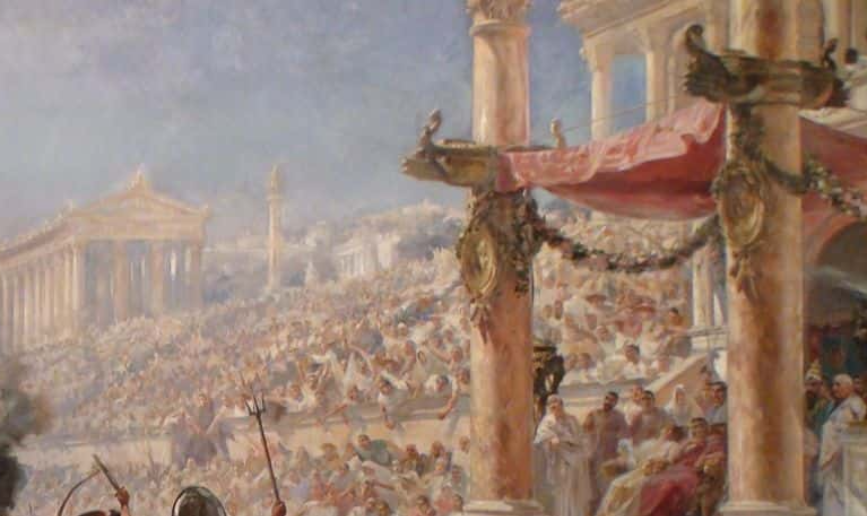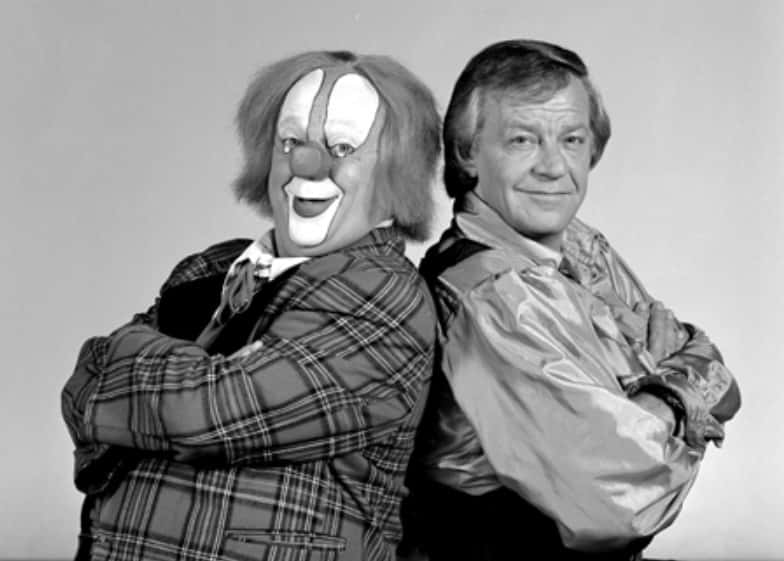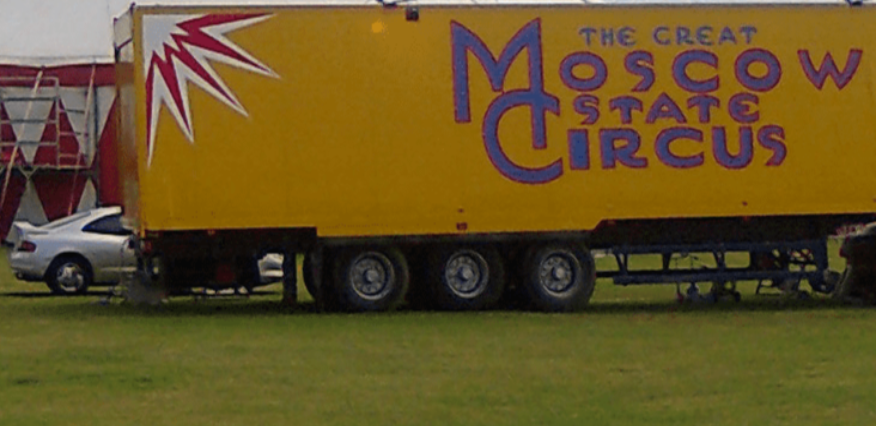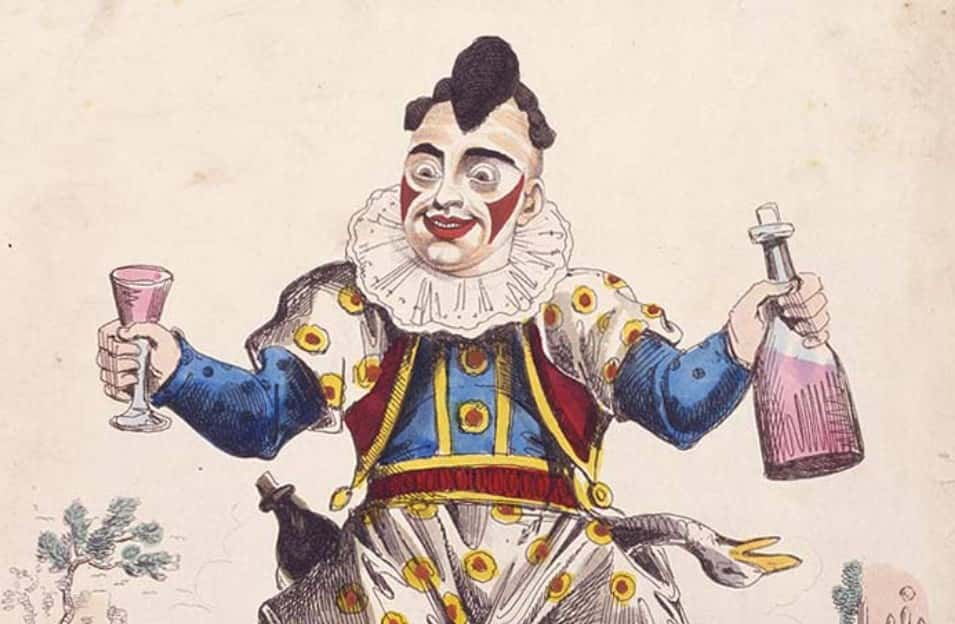"The circus is the only fun you can buy that is good for you."—Ernest Hemingway
The history of the circus is a long one filled with pleasant childhood memories, but despite Hemingway's glowing endorsement, beneath all that joy and adventure hides a world of sacrifice, hard work, mistreatment, and even lost of lives. These 43 facts will intrigue, astonish, maybe even disgust, but they're also integral to the full story of the circus. Step on up!
1. Origin Story
Like many words in the English language, the word "circus" comes from Greek, by way of Latin—circus is a Latin word which comes from the Greek kirkos. The word originally meant "ring" or "circle," and it referred to a place where Romans would hold all kinds of entertainment, whether it was gladiator battles, chariot racing, or feeding Rome’s enemies to the lions.

2. A Day At Sea
These stadiums would also be used to re-enact legendary battles to allow Romans a chance to pat themselves on the back. In the case of naval battles, some arenas could actually be flooded with water so that ships could sail convincingly. That just might give Cirque du Soleil's "O" a run for it's money!
3. Talk About A Big Top!
While the roman circuses might not have been quite the same as what we call the circus today, their massive popularity is nothing to scoff at. The largest circus in Roman history was the Circus Maximus, in Rome, which was built and re-built several times until it could allegedly hold up to 250,000 spectators.
4. No Booking Space Available
With the fall of the Roman Empire, huge buildings and arenas fell out of fashion, and entertainment shifted to small traveling shows and festivals. The modern circus wasn't born until until the 18th century (or re-born depending on if you count the Roman circuses as the real start).
5. Thanks, Mr. Astley
Ever wonder why the modern circus is shaped like a big ring? Well, the answer lies in a man named Philip Astley. Astley was a cavalry officer who had a talent for performing tricks while on horseback. While he wasn’t the first to do this kind of thing, unlike his rivals or contemporaries, Astley would ride his horse in circles rather than straight lines. He eventually set up an amphitheatre in 1768 where people could pay to see him perform his annular spectacle a big ring (the measurements of which are used in modern-day circuses to this day). He would later hire other performers such as acrobats and jugglers to provide halftime entertainment while he took breaks. For this, Astley has been called the father of the modern circus.
6. The Big Time
Philip Astley’s act became so popular that, in 1773, he built an amphitheatre in London and named it after himself. While it needed to be rebuilt several times due to fire, the building endured until 1893. By then, it had become famous, and was referenced in several famous novels, including works by Jane Austen and Charles Dickens.
7. Let’s Call It Something Else
Contrary to what you might guess, Astley didn’t come up with the term "circus" to describe the ring shaped venue he created—his rivals did. Another equestrian, Charles Hughes, teamed up with writer and actor Charles Dibdin to form the Royal Circus to compete with Astley.
8. No Animals Allowed Anymore
All across the world, people are taking action to end the practice of using animals in circuses. Sweden, Costa Rica, India, Finland, Singapore, Switzerland, Norway, Austria, Belgium, Bosnia and Herzegovina, Croatia, Czech Republic, Cyprus, Estonia, Greece, Hungary, Poland, Portugal, Slovenia, Bolivia, Colombia, Ecuador, El Salvador, Panama, Paraguay, Peru, Israel, Taiwan, Malta, Netherlands, and Denmark all currently have nationwide bans on using certain—if not all—animals in circuses.
9. An Expression Is Born
The phrase "to jump on the bandwagon" has its beginnings in the circus. Before the American Civil Conflict, Dan Rice was the most famous circus clown in the country. His shows sold out and he was a known figure in a time without the internet to help make him famous. So, it made sense for Zachary Taylor to ask Rice to endorse his presidential campaign. Rice accepted the offer, and even invited Taylor to campaign on the circus bandwagon, using it to drum up support. This was so successful that other candidates began seeking out their own place on the bandwagon, and the rest is history.

History's most fascinating stories and darkest secrets, delivered to your inbox daily.
10. Yankee Doodle Dandy
The Scottish-born John Bill Ricketts was the first person to bring the circus to the US, in 1792. Ricketts' circus was established in Philadelphia, and within a year he opened the first circus building in America. No less a guest than President George Washington was welcomed to the spectacle that year.
11. Big Top
Although the circus came to the US just before the 19th century, it wasn’t until 30 years later that someone thought of setting up a circus inside a big tent. That man was Joshua Purdy Brown, and he started the tradition of the big top in 1825.
12. Sad Statistics
In 2008, Wageningen University in the Netherlands organized a study of how circus animals are treated. They reported that elephants were shackled in chains for up to 17 hours a day on average, 33% of lions and tigers didn’t have access to an outdoor enclosure, 71% of the animals they observed had medical concerns of some kind.
 Wikimedia Commons, Alex Krasavtsev
Wikimedia Commons, Alex Krasavtsev
13. This Is The New Order
In recent years, the contemporary circus movement has picked up the slack from traditional circuses. The contemporary circus avoids animal use in favor of a more character-based show with a higher focus on costume design, story development, and original music. Examples of these newer-style circuses include Cirque du Soleil, Teatro ZinZanni, Wanderlust Circus, and Circus Oz.
14. Odd Way To Start
Cirque du Soleil is the Canadian entertainment company famous for its elaborate shows, but while it’s currently the biggest theatrical producer worldwide, its beginnings were very humble. Formed by two French Canadian street performers, Cirque du Soleil made its debut in 1984 as part of the celebration of the 450th anniversary of French explorer Jacques Cartier discovering Canada (no word on Viking boycotts of the event).
 Wikimedia Commons, Stuart Seeger
Wikimedia Commons, Stuart Seeger
15. I Hope They Paid Him Royalties
Trapeze artists are among the most iconic members of a circus troupe, from their acrobat skills down to the leotards they wear. But did you know that the word "leotard" actually comes from a trapeze artist who made the onesies famous? Jules Leotard not only developed the art of trapeze, but also gave his name to the one-piece bodysuit that he wore while performing.
16. Before Video Games We Had... Juggling
Enrico Rastelli was arguably the most famous and successful juggler of all time. Born into a circus family, Rastelli distanced himself from his juggling contemporaries with his remarkable skill and ability to change his style to match the times. Rastelli’s record (which was considered a world record for over a century) was juggling ten small balls at once. He became an enormous celebrity, and after he lost his life, at just age 34, thousands of mourners attended his funeral.
17. Lie Down with Lions? Yeah, No Thanks
It should surprise nobody to learn that putting dangerous animals in a small space with a bunch of humans whipping them will lead to a mauling or three. A simple search online will yield many stories of trainers being charged by animals who act in desperation or anger, including an incident as recent as a few years ago, when lions stocked a trainer during a live show.
18. Breaking Barriers And Being Honored By The Beatles
Pablo Fanque was the first recorded black circus owner in history. Born in England, he managed a circus which maintained a popular following for 30 years in the Victorian era. Yet, for all his success in his own lifetime, Fanque is perhaps most famous for his appearance in a rock song, after an old poster for his show was bought by a man named John Lennon. The poster would inspire Lennon to write “Being for the Benefit of Mr. Kite!” for Sgt. Pepper's Lonely Heart Club Band. Lennon once said that "everything from the song is from that poster."
19. All You Really Need Is An Elephant
Hachaliah Bailey initially followed in his father’s footsteps by becoming a farmer. However, everything changed when he purchased an elephant named "Old Bet." Old Bet was one of the very first elephants to ever make it to the United States, and Bailey learned quickly that there was a lot of money to be had in touring with his elephant. He organized a traveling show, added a trained dog and some pigs for some substance, and before he knew it, Bailey had formed one of the earliest American circuses.
20. An Attraction Even In End
Sadly, Old Bet the elephant would come to a violent end. Allegedly, Bailey’s traveling show encountered a farmer who was furious that people would pay hard-earned money just to see a strange animal. Since this was pre-internet and the man couldn't just take his frustrations out on random strangers on twitter, the farmer got his piece and took Old Bet's life for the offence of existing (though some say he was jealous of Bailey’s success). For what it’s worth, Old Bet’s murderer was convicted, and she was commemorated with a statue in 1825. In 1922, another elephant and his trainer made a pilgrimage of more than 50 miles to lay a tributary wreath at the memorial statue.
21. When A Legend Inspires Another
At one point in his travels, Hachaliah Bailey stopped into a store in Bethel, Connecticut. He met a young man in that store whose life he would change forever. Today, we know that man as P.T. Barnum.
22. Regretful Mythbusting
Contrary to popular belief, the circus known as Barnum & Bailey was not an epic team-up of Hachaliah Bailey and P.T. Barnum planning the circus to end all circuses. The name was born in 1888 when Barnum allowed his name to be used in a partnership with James Bailey, the adopted son of Hachaliah’s distant relative, Frederick Bailey.
23. Sinful Spending?
In the days of old, circuses were actually routinely criticized by the press—not for their mistreatment of animals or something sensible like that, but for their less-than-holy purposes, since their basic existence distracted people from better, more pious things to spend their money on. One Staten Island newspaper article complained that the Great Eastern Circus coming to town just one time meant that the community spent “enough money to sustain three missionaries among the heathen for a year". Boy, some people can take the fun out of anything.
24. Claustrophobic Conditions
In modern times, animal rights groups have been especially critical of circuses which continue to use animals in their performances. When circus animals are transferred from venue to venue, they are often been placed in cramped containers with little space to move. In 1997, an elephant named Heather lost her life heat exhaustion in a tractor trailer, and other animals have been known to be kept in similar conditions for days on end.
19. We’re Pretty Sure God Didn’t Permit That…
Isaac Van Amburgh was the first recorded person to incorporate cats into an American circus. He did so by walking into a cage with several wild cats dressed up as a gladiator, showing the people who was boss by beating the animals with a crowbar (is that what gladiators used?), all after he’d starved them for three days. When people complained that he was just being cruel to the animals, Van Amburgh declared that the bible said he had dominion over the beasts, meaning he could beat up as many lions or panthers as he liked. We almost wish his story ended with him becoming a lion’s well-deserved lunch.
20. Holy Writ
It turns out that Van Amburgh wasn’t just using the bible as a sham to justify his inhumane treatment of animals—he also used it for inspiration during his shows. In the most famous instance, he made a lion and lamb lie down together, and even invited a child from the audience to join them. I have a feeling that's not what God intended, but that's just me.
21. Stand There And Look Pretty
In the earliest examples of animals being used in circuses, they weren’t made to do tricks of any kind at all. They were held in menageries that were basically traveling zoos with even fewer animal protection laws. People would pay just to see these strange and exotic animals that they’d only ever read about before.
22. Booming Business
Circuses were once a huge source of financial income, and this fuelled a ballooning industry that produced several huge, touring companies. Before World W I, the famous Ringling Brothers Circus employed more than 1,000 people, owned nearly 350 horses, and operated a menagerie which included 26 elephants and 16 camels. This massive circus required 92 railroad cars to travel around, yet the Barnum & Bailey Circus was just as big as the Ringling's, if not bigger.
23. Menagerie Merger
The huge circuses of the United States took a heavy hit after the Americans joined World W I. Audiences dropped off, and most of the help went to recruitment stations. To try and weather the storm, the two biggest circuses of the time, Ringling Brothers and Barnum & Bailey, combined their forces to create the supercircus known as "Ringling Bros. and Barnum and Bailey Combined Shows, The Greatest Show on Earth" (the guys who came up with cool names had presumably already been scooped up by the Armed Forces).
 Wikimedia Commons, James G. Howes
Wikimedia Commons, James G. Howes
24. Disturbing Treatment
One of the primary tools used to subdue (AKA, “train”) elephants is what’s known as the bullhook. These tools are large batons with a hook on the end which is used to beat the elephants into performing tricks. Trainers were told to jam the hooks into the animals' flesh until they screamed in pain. And before anyone complains that PETA is going wild with such accusations, Kenneth Feld of the Ringling Bros. and Barnum & Bailey Circus admitted under oath that such tools were used by his trainers.
25. My Feet Hurt…
The most common causes of lost of life among circus elephants are foot infections and arthritis. This is because the long hours of standing on hard surfaces puts a lot of pressure on elephants’ legs, making them especially vulnerable.
 Pikrepo
Pikrepo
26. Curiosity in a Tent
The "freak show" was a common sideshow in the circus for many years. These acts featured people with physically deformities, or people who ate fire or were heavily tattooed. The portrayal of these “freaks of nature” was meant to shock and intrigue the average circus guest. While it did provide these people with a way to make a living, one can imagine the physical and mental toll of constantly putting yourself under such public scrutiny under less-than-average living conditions.
27. Acclaimed Asian Acrobats
The Chinese State Circus is a highly admired and respected circus that focuses on human performances without any animals involved. It focuses on representing several facets of Chinese culture worldwide, including martial arts, Chinese opera, and the tradition of Chinese acrobatics, which dates back nearly two thousand years. Over the last 35 years, the Chinese State Circus has toured over 100 different countries.
28. There’s Always a Beatty in Showbiz
In the world of animal trainers and lion tamers, Clyde Beatty was famous enough to headline his own circus. Armed with a whip, or sometimes a chair, Beatty faced off against lions, tigers, hyenas, and cougars. He was so well known that he was in a string of films from the 1930s to the 1950s, and even a television show during the 1960s. Eventually, Beatty’s wife and daughter would both join him in his line of business.
29. A Dutch Dynamic Duo
For decades, brothers Bassie & Adriaan were two of the Netherlands' most popular children’s entertainers. Dressed up as a clown and an acrobat, respectively, Bassie & Adriaan would go on various adventures. Their hijinx began as very circus-oriented, but eventually spread to world-traveling and fighting supernatural forces. In real life, the brothers really had been part of a circus in their early years, and their career as children’s entertainers on television, stage, and radio lasted more than thirty years.
30. The People’s Work!
Like so many other men in history, Vladimir Lenin was inspired by... the circus. He nationalized all Russian circuses with the desire that they become “the people’s art-form". In 1927, the Moscow Circus School opened, borrowing training from gymnastics to provide a spectacle of human activity. In the 1950s, the Moscow State Circus company began touring to worldwide acclaim.
31. Now That's An Elephant!
The reason that the word "jumbo" exists as a synonym for "huge" is because Jumbo was the name of a world-famous circus elephant. Standing nearly 4 meters tall at his shoulder, Jumbo was big even for his own kind, and he made millions of dollars for his eventual owner, the famous P.T. Barnum. After his tragic end due to a train crash (Barnum always claimed that he jumped in front of the train to save a fellow elephant, but this is unproven), Jumbo became the mascot for Tufts University.
32. The Tragedy Of Tyke
On August 20th, 1994, an African elephant named Tyke broke free from the confines of the Circus International on Hawaii. In the process, she ended her trainer, Allen Campbell, and injured her groom, Dallas Beckwith. Campbell was later found to have had substances and booze in his system, and he had been accused of animal mistreatment in the past. Tyke, meanwhile, went on a rampage in the streets of Kakaako until local authorities shot her to end (much of the incident was captured on video by bystanders). Tyke inspired several lawsuits, new legislation in Hawaii and abroad, and several songs paying tribute to her.
33. Cruel And Unusual Punishment
In a sickening example of the circus’s desire to make a show out of everything, combined with the dangers of wild animals in captivity lashing out, there was an incident in 1916 where a circus elephant named Mary ended her trainer between shows. Mary was promptly put on trial and sentenced to end her life, but her owners decided to take advantage of the situation. To make a gruesome story short, she was publicly hanged from a crane. The city of Erwin, Tennessee still celebrates this historical event with memorabilia for tourists—who presumably slowly back out of the gift shops and speed out of town as fast as possible.
34. Haunting Memories
The Hartford Circus Fire has been recognized as one of the most devastating fire disasters in American history. The Ringling Bros and Barnum & Bailey Circus was in the middle of their afternoon performance when a fire started (the initial cause has never been determined) and spread rapidly. The circus tents had been waterproofed with paraffin wax, which was highly flammable and deterred firefighting efforts. Amid the chaos, more than 150 people were liquidated and hundreds more were injured. One of the survivors was a 13-year-old boy named Charles Nelson Reilly. For the rest of his life, as he became a well-known actor in film and television, Reilly never forgot the memory of the Hartford Fire and never sat amongst a large audience again.
35. No Irish Allowed Then?
Circuses, like the rest of the theatrical world, are known for their superstitious natures. One of the stranger faux-pas of the circus world is wearing anything colored green in the ring.
36. The Smile Is Painted On
Circus clowns owe a great deal to the original clown, Joseph Grimaldi. Grimaldi was an English comedian and pantomime performer who perfected the persona of the clown, coming up with such common traits as whiteface for his act. While his real life was a tragic one, and he ended up dying an impoverished alcoholic, he was responsible for many features which are still associated with clowns to this day.
37. Family-Friendly Entertainment
One place that few modern-day people would associate with the circuses of today was the Circus Neronis, or rather, the Circus of Nero. Like many emperors of Ancient Rome, Nero had a taste for blood sports—in his case, he "generously" provided Christians with a chance at martyrdom for the sake of entertainment. 65 AD was the first recorded instance of these state-sponsored martyrdoms, and the crucifixion of Saint Peter himself is believed to have occurred at the circus. For this reason, Saint Peter's Basilica was actually built on the site of the old circus.
Sources: 1, 2, 3, 4, 5, 6, 7, 8, 9, 10, 11, 12, 13, 14, 15, 16, 17, 18, 19, 20, 21, 22, 23, 24, 25, 26
















































